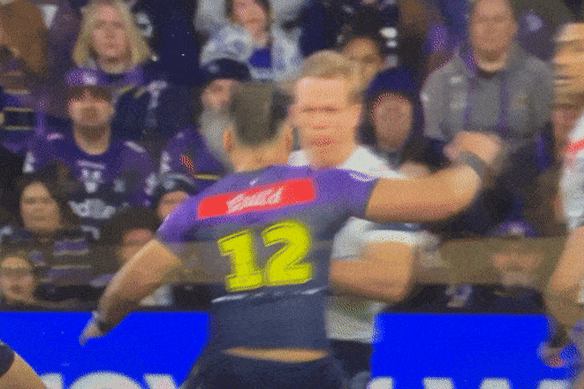
Controversy about cases of concussion following kick-offs won’t go away, and a floated rule change would not only lessen the risk of head injuries, but also open up the possibility of more creative play by the attacking and defending teams.
An NRL game traditionally begins with a soaring kick-off that has a hang time sufficient for forwards to sprint 40 metres downfield to trap the receiving team in its quarter.

Nelson Asofa-Solomona’s tackle on Lindsay Collins which forced the Rooster from the field on the first play.Credit: Nine
The ball is usually caught by a halfback who passes to a giant prop who is traditionally met by 200kgs or more of human bison.
The sight of Roosters prop Lindsay Collins playing the ball in the opposite direction after a collision with the Storm’s giant Nelson Asofa-Solomona in the opening seconds of last season’s preliminary final, as well as other cases, has raised the possibility of a rule change which would see any ball caught on the full inside the 20-metre line result in the receiving team awarded a seven tackle set on the quarter line.
However, after five years of 20 different amendments to the rules, ARLC chairman Peter V’landys says “it would be yet another rule for referees to learn.” True. Last season, despite a rule operating since 2022, there were isolated examples of referees awarding six agains, instead of penalties, to a team attacking out of its 40-metre zone, while also awarding penalties, instead of six agains to a team at the other end of the field.
The NRL is anxious to introduce more contests into the game, given that scrums are no longer competitive, nor is raking for the ball allowed, while the code’s rival, rugby union, prides itself on its variety of challenges for the ball.
Yet, the seven-tackle set for a kick-off caught on the full introduces another contest, while simultaneously reducing the incidence of collisions causing concussion.
It will encourage the kicking team to vary their restarts, seeking to land the ball so it bounces, or comes down swirling under a nervous catcher, rather than land in the arms of a reliable No 7.









 Add Category
Add Category